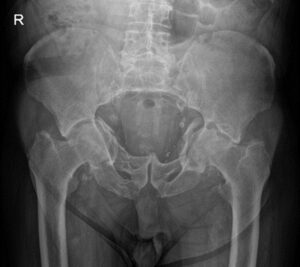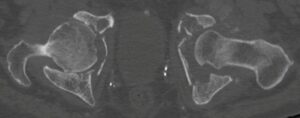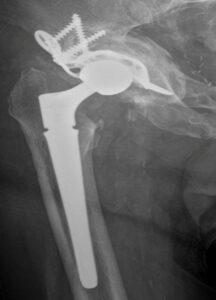Alessandro Ivone1*, Andrea F Fusaro1, Andrea Viti2, Roberto E Vanelli1
1ASST Nord Milano-Ospedale Edoardo Bassini, Italy
2Fondazione IRCCS Policlinico San Matteo, Italy
*Correspondence author: Alessandro Ivone, ASST Nord Milano-Ospedale Edoardo Bassini, Italy;
Email: [email protected]
Published Date: 07-10-2024
Copyright© 2024 by Ivone A, et al. All rights reserved. This is an open access article distributed under the terms of the Creative Commons Attribution License, which permits unrestricted use, distribution, and reproduction in any medium, provided the original author and source are credited.
Abstract
The case report talks about the surgical treatment of bilateral hip osteonecrosis after radiotherapy. The literature is poor on the subject even if a cause-effect correlation is described between radiotherapy and bone necrosis. This clinical case underlines the correlation between pelvic irradiation and radiation-induced fractures due to bone weakening. The evaluation about choice and survival of the implant used is interesting for future comparisons and surgical approach.
Keywords: Hip Osteonecrosis; Radiation Therapy; Pelvis Irradiation; Fractures
Introduction
Surgical treatment combined with radiation therapy is a well-established therapeutical approach when dealing with prostate cancer. When the tumor is localized, without distant metastases, radiotherapy is effective in eliminating residual disease or disease recurrences. However, a series of side effects have been shown, especially involving adjacent anatomical districts, such as treatment-induced osteoporosis of the hip region. Nowadays is well-known that bone metastases, which are usually osteoblastic lesions, are commonly found in patients with prostate cancer, with a great impact on the painful symptomatology and the overall quality of life. Despite this, no evidence of bone metastases has been detected in our patient. Thus, the correlation between acetabular fractures and bilateral coxarthrosis appeared to be due to radiation-induced bone weakening after irradiation of the pelvis. Symptoms of insufficiency fractures include hip and lumbo-sacral pain that can lead to immobilization, with a great negative impact on the patient’s quality of life. These symptoms can occur within 2 months of radiotherapy up to 63 months after treatment, with a median incidence of 6-20 months after [1]. These adverse events are peculiar since they can present, in a subtle way, even years after radiotherapy cycles, firstly with worsening functional limitations during prolonged load bearing and walking, until arriving to absolute impotence. When combining surgery and radiation therapy, lots of complications can occur, such as wound healing disorders, bone and soft tissues damage and necrosis and an increased risk of pathological fractures. This is especially true for long bones, such as the femur but every bony region can be affected. Few studies show the long-term effects of pelvis irradiation [2,3]. However, fractures are among the most common side-effects [1,4]. Some retrospective studies have identified a greater risk of long-term side effects and particularly of hip fractures, after cancer treatment with EBRT (External Beam Radiotherapy), the most common type of radiation therapy in which the patient is sitting or lying down on the bed and an external beam of ionizing radiations is directed over a specific body district. It is well-known that gynecological malignancies and women anorectal cancer treated with EBRT have an increased risk of hip bone fractures [5,6]. The pathophysiology underlying this side effect can be described as an osteonecrosis induced by the radiation beam that pass across bones while reaching its target [7-9]. The radiation-induced damage involves the bone matrix, at a cellular and vascular level [7]. Radiations can cause the death of osteoblasts, osteocytes and osteoclasts, leading to a reduced production of bone matrix. Also, the radiation beam can damage the bone vascular supply, increasing tissue loss [9]. In fact, radiation therapy to the prostate have been associated with fractures of the femur, the ileopubic and ischiopubic rami, the pubic symphysis, the acetabulum and avascular necrosis of the hip [8-10]. Radiation-induced fractures are harder to treat and hip replacement after radiotherapy has an increased risk of failure due to infection or malfunction [8,11]. Taking into account a study of few years ago, which considered only male sex for the first time, in patients over 65 years old with prostate cancer treated with EBRT the risk of hip fractures increased by 76% with respect to the population [12]. Since these insufficiency fractures can occur without any trauma to the pelvis, they can remain underdiagnosed for a long time with a strong impact on the painful symptomatology and the quality of life of the patient.
This pathology is still underreported and few evidence are available regarding the etiology, the risk factors and the gold-standard for the management of bone health in this set of patients [1]. Since radiation-induced pathological fractures, particularly at the level of the hip, are associated with and increased rate of morbidity and mortality early diagnosis is of vital importance and should be stressed out [13,14].
Case Report
Male patient of 80 years old arrived at the emergency room of our hospital in May 2021 with acute bilateral groin pain, which arose spontaneously while getting out of the bed; the pain was so intense that the patient had difficulty during walking, with a marked limp. In the medical history of the patient, among less relevant conditions, we found osteoporosis and prostate cancer for which the patient underwent in 2013 radical prostatectomy followed by pelvic radiotherapy for disease recurrence. Clinical and radiographic investigations were carried out in the Emergency Department, with the finding of bilateral coxarthrosis with deformation of the femoral heads, both protruding into the pelvic space due to the presence of acetabular fractures with hardly appreciable fracture lines and reactive calcifications (Fig. 1). Since the patient had no traumatic event and considering his previous pelvic irradiation treatment for the prostate cancer, a pathological stress fracture was suspected and a CT scan was performed, which confirmed bilateral coxarthrosis and acetabular fractures with both femoral heads protruding into the pelvis, together with fractures of the ischiopubic and ileopubic rami, bilateral hip joint effusion and hypotonia of adjacent muscles. Left side was more severe (Fig. 2). To have a better overview of the clinical case, an MRI was performed in June 2021, which described extensive signal alterations characterized by T1 signal hypointensity and STIR sequences hyperintensity referable to edema, both in correspondence of the acetabular roofs and of the acetabular rims; these alterations were also present at the level of the proximal third of both femurs that also had signs of osteonecrosis foci. The magnetic resonance confirmed the femoral heads deformation, greater on the left side and the massive bilateral hip joint effusion associated with edema at the level of the ileopubic rami, the pubic symphysis and partially at the level of the ischiopubic rami. In November 2021, based on the imaging findings and on the symptomatology of the patient who in the meantime lost every deambulatory skill, a surgical treatment for the left hip was proposed; surgical planning included impaction bone grafting of the acetabular fundus using donor bone, acetabular cage with cemented component and cementless femoral stem. During femoral medullary canal preparation, a fracture line of about 2 cm on the anteromedial surface of the canal, near the lesser trochanter, was noted; thus, to avoid further progression of the fracture, two metallic cerclages were positioned (Fig. 3). On hospital discharge the patient was allowed to have a partial weight bearing on the left inferior limb during walking using aids and physiokinesitherapy was prescribed aimed at active and passive mobilization of the hip and strengthening of the quadriceps and gluteal muscles.
The patient had an optimal post-surgical and rehabilitative process and thus in May 2022 the same surgical intervention was performed also on the right side; however, on the side we used a cementless modular double conical stem (Fig. 4,5). Same post-surgical and rehabilitative indications were given at discharge.
Up to now the patient is in follow-up (1 year FU for the left side and 6 months FU for the right side) and is walking using aids, pain at passive and active mobilization of the hips is gradually improving and physiotherapy is still necessary especially for the right side were quadriceps hypotonia is present. The patient reports being satisfied with the overall conditions achieved so far and actively continues the rehabilitation process.

Figure 1: First X-ray in emergency room: bilateral coxarthrosis with deformation of the femoral heads, both protruding into the pelvic space due to the presence of acetabular fractures with hardly appreciable fracture lines and reactive calcifications.

Figure 2: CT scan: bilateral coxarthrosis and acetabular fractures with both femoral heads protruding into the pelvis, together with fractures of the ischiopubic and ileopubic rami, bilateral hip joint effusion and hypotonia of adjacent muscles. Left side was more severe.

Figure 3: Postoperative X-ray of left hip.

Figure 3: Postoperative X-ray of left hip.

Figure 5: Postoperative X-ray of right hip.
Discussion
This clinical case underlines the correlation between pelvic irradiation and radiation-induced fractures due to bone weakening. Nowadays radiation therapy is the gold-standard for the treatment of many tumors, alone or in combination with surgery and chemotherapy. For this reason, is of vital importance to know how to predict and recognize the short and long-term side effects that can occur to adjacent structures of the irradiated target. Fractures appear to be one of the most frequent side-effects, with a variable time presentation. The cause-effect link between radiotherapy and the risk of fracture lies in the demolition action of the radiant beam against the bone cell population (osteoblasts, osteocytes and osteoclasts) and therefore in the quality and quantity of bone matrix produced in the territory affected by the passage of the beam during its journey towards the target to be treated. These risks had already been pointed out by a series retrospective study, however the evidence that radiotherapy increase the risk of fractures at the hip level by 76% in male over 65 with prostate cancer emerged only recently. In fact, our patient seems to clearly demonstrate the link between radiotherapy and bone suffering. In order to achieve the best outcome possible, the surgical treatment of our patient was made using a succession of pre-operative plannings that best suited with the extent and the evolution of the femoral and pelvic lesions showed by the imaging.
Dealing with a pathological bilateral condition, firstly we treated the most symptomatic side, the left one, with a total hip replacement with an acetabular cage and donor bone graft. Given the positive outcome of this first surgery, a similar choice was taken also for the contralateral side.
A year has passed since the surgery of the left hip and 6 months since the one of the right side and up to now, after a strict rehabilitation process, the patient is satisfied with the results achieved so far: he is able to walk using crutches and a good level of independency have been reached; however, physiotherapy is still necessary to improve muscle tone, especially on the right side where quadriceps hypotonia persists.
Our surgical team followed the patient since the beginning, studying the case from the first access to the Emergency Department up to now, since the follow-up is still ongoing. The correlation between the orthopedic pathology and the clinical history of our patient seems clear, but to date scientific studies on the etiology of pathological stress fractures, especially in males, are too few to be able to definitively validate the cause-effect link exposed so far. Clinical insights on a numerically significant cohort of patients, the execution of targeted instrumental and laboratory investigations and a standardized follow-up could be essential in identifying the link between radiotherapy and bone weakening, which is fundamental to elaborate a preventive or therapeutic approach for this debilitating condition still poorly characterized today.
Conflict of Interests
The author declares that he has no conflict of interest in this paper.
Authors’ Contributions
All authors contributed equally in this paper.
References
- Higham CE, Faithfull S. Bone health and pelvic radiotherapy. Clin Oncol (R Coll Radiol). 2015;27:668‐78.
- Fein DA, Lee WR, Lanciano RM, Corn BW, Herbert SH, Hanlon AL, et al. Management of extremity soft tissue sarcomas with limb-sparing surgery and postoperative irradiation: do total dose, overall treatment time and the surgery-radiotherapy interval impact on local control? Int J Radiat Oncol Biol Phys. 1995;32(4):969-76.
- Kim HJ, Boland PJ, Meredith DS, Lis E, Zhang Z, Shi W, et al. Fractures of the sacrum after chemoradiation for rectal carcinoma: incidence, risk factors and radiographic evaluation. Int J Radiat Oncol Biol Phys. 2012;84:694‐9.
- Schmeler KM, Jhingran A, Iyer RB, Sun CC, Eifel PJ, Soliman PT, et al. Pelvic fractures after radiotherapy for cervical cancer: implications for survivors. Cancer. 2010;116:625‐30.
- Baxter NN, Habermann EB, Tepper JE, Durham SB, Virnig BA. Risk of pelvic fractures in older women following pelvic irradiation. JAMA. 2005;294(20):2587-93.
- Tosteson AN, Gottlieb DJ, Radley DC, Fisher ES, Melton LJ. Excess mortality following hip fracture: the role of underlying health status. Osteoporos Int. 2007;18(11):1463-72.
- Hopewell JW. Radiation-therapy effects on bone density. Med Pediatr Oncol. 2003;41(3):208-11.
- Jacobs JJ, Kull LR, Frey GA, Gitelis S, Sheinkop MB, Kramer TS, et al. Early failure of acetabular components inserted without cement after previous pelvic irradiation. J Bone Joint Surg Am. 1995;77(12):1829-35.
- Mumber MP, Greven KM, Haygood TM. Pelvic insufficiency fractures associated with radiation atrophy: clinical recognition and diagnostic evaluation. Skeletal Radiol. 1997;26(2):94-9.
- Fu AL, Greven KM, Maruyama Y. Radiation osteitis and insufficiency fractures after pelvic irradiation for gynecologic malignancies. Am J Clin Oncol. 1994;17(3):248-54.
- Massin P, Duparc J. Total hip replacement in irradiated hips. A retrospective study of 71 cases. J Bone Joint Surg Br. 1995;77(6):847-52.
- Elliott SP, Jarosek SL, Alanee SR, Konety BR, Dusenbery KE, Virnig BA. Three-Dimensional external beam radiotherapy for prostate cancer increases the risk of hip fracture. Cancer. 2011;117(19):4557-65
- Center JR, Nguyen TV, Schneider D, Sambrook PN, Eisman JA. Mortality after all major types of osteoporotic fracture in men and women: an observational study. Lancet. 1999;353(9156):878-82.
- Cooper C. The crippling consequences of fractures and their impact on quality of life. Am J Med. 1997;103(2):S12-9.
Article Type
Case Report
Publication History
Accepted Date: 16-09-2024
Accepted Date: 30-09-2024
Published Date: 07-10-2024
Copyright© 2024 by Ivone A, et al. All rights reserved. This is an open access article distributed under the terms of the Creative Commons Attribution License, which permits unrestricted use, distribution, and reproduction in any medium, provided the original author and source are credited.
Citation: Ivone A, et al. Radiation-Induced Bilateral Hip Osteonecrosis and Acetabular Fractures. J Ortho Sci Res. 2024;5(3):1-6.

Figure 1: First X-ray in emergency room: bilateral coxarthrosis with deformation of the femoral heads, both protruding into the pelvic space due to the presence of acetabular fractures with hardly appreciable fracture lines and reactive calcifications.

Figure 2: CT scan: bilateral coxarthrosis and acetabular fractures with both femoral heads protruding into the pelvis, together with fractures of the ischiopubic and ileopubic rami, bilateral hip joint effusion and hypotonia of adjacent muscles. Left side was more severe.

Figure 3: Postoperative X-ray of left hip.

Figure 3: Postoperative X-ray of left hip.

Figure 5: Postoperative X-ray of right hip.


